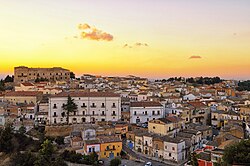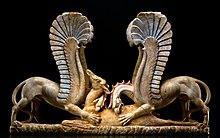Ascoli Satriano
Ascoli Satriano
Àsculë(Neapolitan) | |
|---|---|
| Comune di Ascoli Satriano | |
 | |
| Coordinates:41°12′56″N15°33′28″E/ 41.21556°N 15.55778°E | |
| Country | Italy |
| Region | Apulia |
| Province | Foggia(FG) |
| Frazioni | San Carlo |
| Government | |
| • Mayor | Vincenzo Sarcone |
| Area | |
| • Total | 333.68 km2(128.83 sq mi) |
| Elevation | 393 m (1,289 ft) |
| Population (30 April 2017)[3] | |
| • Total | 6,188 |
| • Density | 19/km2(48/sq mi) |
| Demonym | Ascolani |
| Time zone | UTC+1(CET) |
| • Summer (DST) | UTC+2(CEST) |
| Postal code | 71022 |
| Dialing code | 0885 |
| Patron saint | San Potito |
| Saint day | January 14 |
| Website | Official website |


Ascoli Satriano(Italian:[ˈaskolisatriˈaːno];Foggiano:Àsculë) is a town andcomunein theprovince of Foggiain theApuliaregion of southeastItaly.It is located on the edge of a large plain in Northern Apulia known as theTavoliere delle Puglie.[4]
History
[edit]The earliest human presence in the area of Ascoli Satriano dates from around the 9th century BC, according to archaeological evidence, and similar dated earthworks are common in the area.[4]It was a small village eventually on a branch of theAppian WayinApulia,South EastItaly.
Asculumwas a town of theDauniorSatriani,a warlike tribe. Two battles were fought there. Asculum gave effective help to the Romans at the firstBattle of Asculumin 279 BC,[5]which was the first of KingPyrrhus of Epirus'sPyrrhic victoryagainst theRoman Republicduring thePyrrhic War.[6]This was followed by theBattle of Asculum (209 BC),during theSecond Punic War,in whichHannibaldefeated a Roman army commanded byMarcus Claudius Marcellusin an indecisive battle.[7]
TheBattle of Canusiumalso took place nearby. In theSocial Warthe city took the Italian side against Rome, and the end of that war, at theBattle of Asculum (89 BC),the victorious Romans besieged the town, starved it to surrender, executed the adult male prisoners by flogging and decapitation, and burned the town. Those noncombatants who survived were left to wander without support. The Roman general responsible,Gnaeus Pompeius Strabo,gained the nicknameCarnifex( "Butcher" ). LaterSullaestablished a military colony there.
In the Roman period it became a small cluster of habitations in a wider network of scattered villas. Under theRoman Empirethe economy was operated by slave labour and focused on grain cultivation.[4]The large luxurious villa at Faragola was typical of alatifundium.
As theWestern Roman Empirebegan to collapse in the fourth and fifth centuries, many of the surrounding farms were abandoned with a retraction of cultivation and a re-growth of woodlands.[4]In the mid-9th century theSaracensrazed the city. In 1040 it rebelled against theByzantinesand, the following year, a decisive battle was fought nearby which granted theNormanscontrol over southernItaly.Anearthquakein 1456 totally destroyed Ascoli Satriano, and forced relocation of the surviving inhabitants to the site of the current town. Re-growth of the town however was interrupted by periodic outbreaks ofplagueandtyphusinto the early 19th Century.[4]
From the end of the nineteenth century the Ascoli Satriano was affected by increasing emigration to the Americas, reaching a peak between 1903 and 1914, stopping during the periods of theFirst World WarandItalian fascism.After thebombing of Foggiain 1943, Ascoli Satriano was freed by British and American forces.
Ascoli Satriano was mentioned by the Irish writerJames Joycein his novelUlysses.
After the Second World War, Ascoli Satriano, close to Cerignola, was the center of significant labor struggles againstlandlordism,sharecroppingand low wages, and strikes, demonstrations and land occupations became frequent. Trade unionists and politicians made passionate speeches to organize to support the demands of the working classes in Piazza Cecco d'Ascoli (today Piazza Giovanni Paolo II).
Main sights
[edit]- The Romanesque-Gothic Cathedral (12th century)
- Church of St. John the Baptist (12th century)
- Church of theIncoronata(15th century)
- TheMuseum Centre of Ascoli Satrianohouses theMarbles of Ascoli Satriano,a set of marble artifacts from the 4th century BC believed to been taken from a tomb of an elite prince of the region.
- Roman villa Faragola
People
[edit]- Biagio Ciotto,American politician.
- Michele Placido,actor and film director
References
[edit]- ^"Superficie di Comuni Province e Regioni italiane al 9 ottobre 2011".Italian National Institute of Statistics.Retrieved16 March2019.
- ^"Ascoli Satriano".Tuttitalia(in Italian).
- ^All demographics and other statistics from the Italian statistical institute (Istat)
- ^abcdeCurtis, Daniel.Is there an ‘agro-town’ model for Southern Italy? Exploring the diverse roots and development of the agro-town structure through a comparative case study in Apulia.Continuity and Change Vol. 28 (03) December 2013, pp 377 - 419 DOI: 10.1017/S0268416013000362, Published online: 27 November 2013.
- ^Edlund Berry, I.; A. Small; DARMC; R. Talbert; S. Gillies; T. Elliott; J. Becker."Places: 442487 (Ausculum)".Pleiades.RetrievedDecember 28,2013.
- ^Carey, Brian Todd (2007).Hannibal's Last Battle: Zama and the Fall of Carthage.South Yorkshire, UK: Pen and Sword. p. 21.ISBN9781844156351.
- ^Nash, Pete (2016).Mythic Rome.Aeon Games Publishing. p. 210.ISBN9781911471134.
External links
[edit]- The Museum Center of Ascoli SatrianoArchived2019-01-24 at theWayback Machine(in Italian)
- A late Roman villa at Faragola (Ascoli Satriano), ITALYDipartimento di Scienze Umane, Area di archeologia - Università degli Studi di Foggia.




